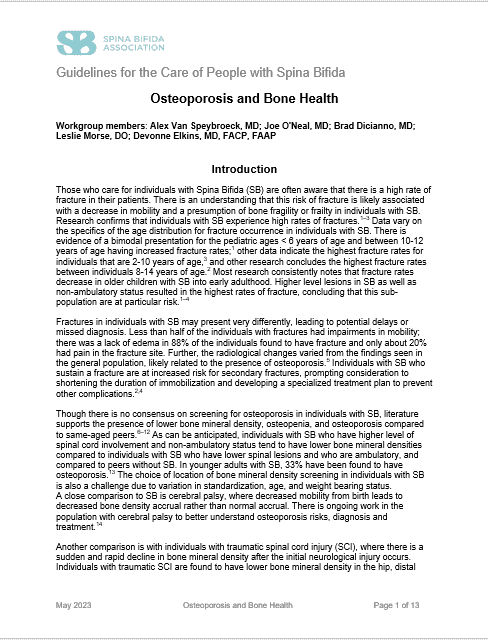Delivering the Diagnosis to Expectant Parents
It’s never easy or pleasant to give expectant parents news that their baby has been affected by Spina Bifida (SB). In order to help you provide the best care possible for your patients, and to help expectant parents full explore the options they have, the Spina Bifida Association (SBA) wants to ensure that you have the most current and accurate information about Spina Bifida.
What you may remember about SB does not necessarily reflect the advances in medical and psychosocial care over the last generation.
What is Spina Bifida?
Spina Bifida is a general term used to describe a variety of different neural tube defects. The most common open neural tube defect is Myelomeningocele. When most people speak of Spina Bifida they are referring to Myelomeningocele.\
What Causes Spina Bifida?
No one knows for certain what causes Spina Bifida. The role that genetics and the environment play in causing spina bifida needs to be studied further.
Spina bifida happens in the first few weeks of pregnancy, often before a woman knows she’s pregnant. Although folic acid is not a guarantee that a woman will have a healthy pregnancy, taking folic acid can help reduce a woman’s risk of having a pregnancy affected by Spina Bifida. Because half of all pregnancies in the United States are unplanned, it is important that all women who can become pregnant take 400 mcg of folic acid daily.
Medical Issues
Hydrocephalus
About 80% of indiviudals with SB develop hydrocephalus due to the presence of the Arnold Chiari malformation. For some, it appears that they develop some degree of hydrocephalus in utero. For many individuals, hydrocephalus develops post-natally, after surgical closure of the back.
Mobility
This issue is dependent on the spinal level of the SB lesion. Most children are able to walk (though usually with the aid of orthopedic bracing and assistive devices such as crutches). Some are full-time walkers, but many walk short distances and choose a wheelchair or electric cart for long distances. It is generally only those with thoracic or high lumbar spinal lesions who end up using the wheelchair as their only method of mobility.
Neurogenic Bowel and Bladder
This is common in SB because the nerves that control the bladder, anus and a small segment of the sigmoid colon are controlled by sacral nerve roots (S2-S4). It is important to develop a plan for going to the bathroom that works and is as simple as possible.
Intelligence and Learning Issues
Most people with SB have normal IQ scores, but may have learning difficulties. These can often be addressed when parents and teachers understand the issues and work together.
Quality of Life in Adulthood
Research over the last decade has demonstrated that self-perceived quality of life for persons with SB does not appear to be influenced primarily by medical issues (though medical issues may in influence quality of life at times of medical crisis or stress). Rather, studies have shown that for most individuals with SB, quality of life is more strongly associated with the individual’s beliefs and experiences and that the family also influence the individual’s beliefs in his or her capabilities. (Sawin & Bellin, 2010). Thus, lack of independence in persons with SB today appears to be more strongly influenced by learning issues that are inadequately addressed, and by negative attitudes and societal limits.
When Delivering the Diagnosis
- Acknowledge your level of understanding about SB.
- Avoid giving a definitive prognosis
- Be careful not to infer blame, it is no one’s fault.
- See PDF for more information
Referrals
- As soon as possible, refer the patient to a pediatric neurosurgeon, and/or to an SB clinic to get more information.
- Ensure that the people you refer to have the most current diagnostic information (fetal ultrasounds or MRI scans). That will ensure that the consultants are able to give the most accurate information about what to expect in the future should families decide to continue with the pregnancy.
- Families may also benefit from referral to a geneticist or genetic counselor
- Pregnant women should be referred to a maternal-fetal medicine specialist.
- Women who wish to consider the option of fetal surgery will need an immediate referral to a center experienced in this intervention. It is important to note that not all women with an affected fetus are candidates for the procedure.
- Let families know about the Spina Bifida Association. SBA has many resources that are useful and informative to families. Our National Resource center is available to answer any questions and link families to a local Chapter or support group.
This information does not constitute medical advice for any individual. As special cases may vary from the general information presented here, SBA advises readers to consult a qualified medical or other professional on an individual basis.
Connect with other Spina Bifida Professionals
SBA has a network of health care professionals serving the Spina Bifida community and have Guidelines for the Care of People with Spina Bifida.
Guidelines for the Care of People with Spina BifidaTags


